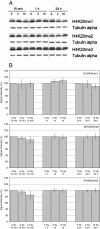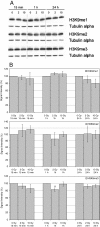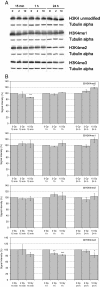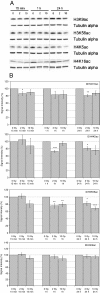Radiation-induced alterations of histone post-translational modification levels in lymphoblastoid cell lines
- PMID: 24406105
- PMCID: PMC3903440
- DOI: 10.1186/1748-717X-9-15
Radiation-induced alterations of histone post-translational modification levels in lymphoblastoid cell lines
Abstract
Background: Radiation-induced alterations in posttranslational histone modifications (PTMs) may affect the cellular response to radiation damage in the DNA. If not reverted appropriately, altered PTM patterns may cause long-term alterations in gene expression regulation and thus lead to cancer. It is therefore important to characterize radiation-induced alterations in PTM patterns and the factors affecting them.
Methods: A lymphoblastoid cell line established from a normal donor was used to screen for alterations in methylation levels at H3K4, H3K9, H3K27, and H4K20, as well as acetylation at H3K9, H3K56, H4K5, and H4K16, by quantitative Western Blot analysis at 15 min, 1 h and 24 h after irradiation with 2 Gy and 10 Gy. The variability of alterations in acetylation marks was in addition investigated in a panel of lymphoblastoid cell lines with differing radiosensitivity established from lung cancer patients.
Results: The screening procedure demonstrated consistent hypomethylation at H3K4me3 and hypoacetylation at all acetylation marks tested. In the panel of lymphoblastoid cell lines, however, a high degree of inter-individual variability became apparent. Radiosensitive cell lines showed more pronounced and longer lasting H4K16 hypoacetylation than radioresistant lines, which correlates with higher levels of residual γ-H2AX foci after 24 h.
Conclusion: So far, the factors affecting extent and duration of radiation-induced histone alterations are poorly defined. The present work hints at a high degree of inter-individual variability and a potential correlation of DNA damage repair capacity and alterations in PTM levels.
Figures






Similar articles
-
Solar Simulated Ultraviolet Radiation Induces Global Histone Hypoacetylation in Human Keratinocytes.PLoS One. 2016 Feb 26;11(2):e0150175. doi: 10.1371/journal.pone.0150175. eCollection 2016. PLoS One. 2016. PMID: 26918332 Free PMC article.
-
Cross-talk between the H3K36me3 and H4K16ac histone epigenetic marks in DNA double-strand break repair.J Biol Chem. 2017 Jul 14;292(28):11951-11959. doi: 10.1074/jbc.M117.788224. Epub 2017 May 25. J Biol Chem. 2017. PMID: 28546430 Free PMC article.
-
Differential effects of garcinol and curcumin on histone and p53 modifications in tumour cells.BMC Cancer. 2013 Jan 29;13:37. doi: 10.1186/1471-2407-13-37. BMC Cancer. 2013. PMID: 23356739 Free PMC article.
-
Epigenetic landscape of amphetamine and methamphetamine addiction in rodents.Epigenetics. 2015;10(7):574-80. doi: 10.1080/15592294.2015.1055441. Epigenetics. 2015. PMID: 26023847 Free PMC article. Review.
-
Lysine methylation: beyond histones.Acta Biochim Biophys Sin (Shanghai). 2012 Jan;44(1):14-27. doi: 10.1093/abbs/gmr100. Acta Biochim Biophys Sin (Shanghai). 2012. PMID: 22194010 Review.
Cited by
-
The Advances in Epigenetics for Cancer Radiotherapy.Int J Mol Sci. 2022 May 18;23(10):5654. doi: 10.3390/ijms23105654. Int J Mol Sci. 2022. PMID: 35628460 Free PMC article. Review.
-
Transcriptomic and Epigenomic Profiling of Histone Deacetylase Inhibitor Treatment Reveals Distinct Gene Regulation Profiles Leading to Impaired Neutrophil Development.Hemasphere. 2019 Aug 7;3(4):e270. doi: 10.1097/HS9.0000000000000270. eCollection 2019 Aug. Hemasphere. 2019. PMID: 31723844 Free PMC article.
-
Radiation-Induced Normal Tissue Damage: Oxidative Stress and Epigenetic Mechanisms.Oxid Med Cell Longev. 2019 Nov 12;2019:3010342. doi: 10.1155/2019/3010342. eCollection 2019. Oxid Med Cell Longev. 2019. PMID: 31781332 Free PMC article. Review.
-
Differences in DNA Repair Capacity, Cell Death and Transcriptional Response after Irradiation between a Radiosensitive and a Radioresistant Cell Line.Sci Rep. 2016 Jun 1;6:27043. doi: 10.1038/srep27043. Sci Rep. 2016. PMID: 27245205 Free PMC article.
-
Alterations in histone acetylation following exposure to 60Co γ-rays and their relationship with chromosome damage in human lymphoblastoid cells.Radiat Environ Biophys. 2018 Aug;57(3):215-222. doi: 10.1007/s00411-018-0742-9. Epub 2018 May 17. Radiat Environ Biophys. 2018. PMID: 29774413
References
Publication types
MeSH terms
Substances
LinkOut - more resources
Full Text Sources
Other Literature Sources
Miscellaneous

